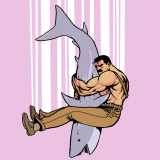On Uncharted and characterization through play.
By MSG 2 Comments
Uncharted 2 and 3 are special games.
While Naughty Dog’s latest pulp adventure might pull a few too many of the same tricks as its predecessor, they are damn fine tricks and no one else in the video game industry has even attempted to replicate them.
Sure, I’m talking about the massive set pieces — running through burning buildings; hanging onto a piece of free falling cargo hundreds of feet above an endless desert – but what really sets Uncharted apart is its characters.
Naughty Dog has done a great job of bringing Nathan Drake and the series’ supporting cast to life. The characters may be simple adventure flick stereotypes, (hey, it’s pulp, not Tolstoy) their relationships feel real and my attachment to them is staggering.
But what is it that makes Uncharted better at this than most other games? There’s the care and attention given to the writing, of course, but I think it’s something simpler; something only a video game could do.
Minor Uncharted 3 spoilers ahead!
I’m going to call it “characterization through play.” While most of the characterization we get in video games is through writing, whether it be in dialogue or narration, the Uncharted games draw you closer to their hero by letting you control him.
I’m talking about controlling Drake as he slowly stumbles through a bar restroom, battered and bloody. I’m talking about controlling a delusional and broken Drake as he hopelessly walks through a massive desert.
It’s moments like these, moments where Naughty Dog puts the player in control while slyly reminding them that Drake is no superman by changing the way they control him. They limit the player’s movement, taking it down from a run to a wobbly, hand-over-probably-broken-ribs walk.
The player is now just as beaten down as Drake. It gives meaning to the brutal fistfight we just won and it brings the player closer to the character. We now have the same limitations, the same probably broken ribs. It creates empathy. It creates an emotional attachment.
This technique is astonishingly simple, but most developers fail to take advantage of it, or do it poorly. It’s not enough to just force the player to slow down. You need to sell this moment. Make the player experience the pain and emotion of the character. Make them one.
Uncharted has a few more tricks up its sleeve that should be part of this conversation. The franchise’s combat is improvisational in nature: grab a gun here, duck behind cover there, dump a few rounds into some enemies, scramble toward new cover and stop to punch a new enemy along the way.
This desperate scramble is an extension of Drake’s personality. While he might be the world’s most prolific murderer, he’s certainly no expert tactician. He’s just lucky. He rolls with whatever happens to fall into his hands. When the bullets run out, he’ll just grab something else off the floor, probably the AK-47 of a pirate who surprised him and was promptly punched in the balls.
This is obviously a technique that only applies to player characters, but Uncharted is really about Drake. Start caring about him and you’ll come to care about his associates.
I’m also not discounting the writing at all. That’s still the real meat of what’s going on in these games, but Uncharted is using interactivity to build a relationship with its hero that no other games in this space are even attempting. That’s a special thing.

2 Comments